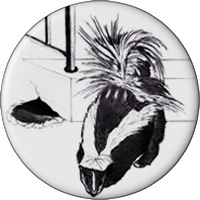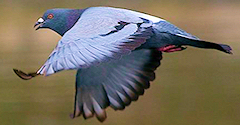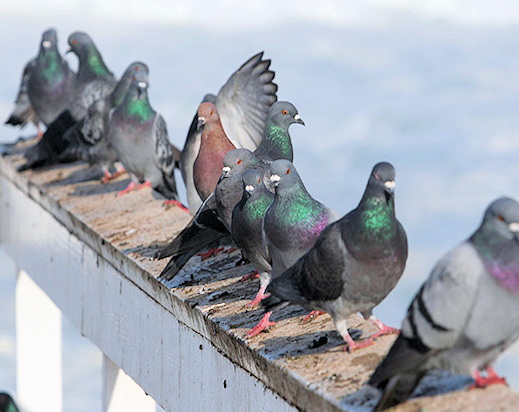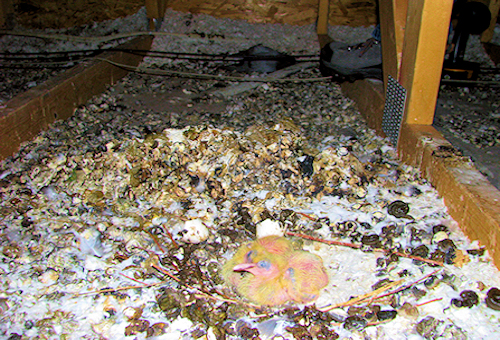PigeonsIdentification
Food Habits Pigeons are primarily grain and seed eaters and will subsist on spilled or improperly stored grain. They also will feed on garbage, livestock manure, insects, or other food materials provided for them intentionally or unintentionally by people. In fact, in some urban areas the feeding of pigeons is considered a form of recreation. They require about 30 ml (1 ounce) of water daily. They rely mostly on free-standing water, but they can also use snow to obtain water. General Biology, Reproduction, and Behaviour
Pigeons are monogamous. Eight to 12 days after mating, the females lay 1 or 2 eggs which hatch after 18 days. The male provides nesting material and guards the female and the nest. The young are fed pigeon milk, a liquid-solid substance secreted in the crop of the adult (both male and female) that is regurgitated. The young leave the nest at 4 to 6 weeks of age. More eggs are laid before the first clutch leaves the nest. Breeding may occur during all seasons, but peak reproduction occurs in the spring and fall. A population of pigeons usually consists of equal numbers of males and females. In captivity, pigeons commonly live up to 15 years and sometimes longer. In urban populations, however, pigeons seldom live more than 3 or 4 years. Natural mortality factors, such as predation by mammals and other birds, diseases, and stress due to lack of food and water, reduce pigeon populations by approximately 30% annually. Damage
Pigeons may carry and spread diseases to people and livestock through their droppings. They are known to carry or transmit pigeon ornithosis, encephalitis, Newcastle disease, cryptococcosis, toxoplasmosis, salmonella food poisoning, and several other diseases. Additionally, under the right conditions pigeon manure may harbour airborne spores of the causal agent of histoplasmosis, a systemic fungus disease that can infect humans. The ectoparasites of pigeons include various species of fleas, lice, mites, ticks, and other biting insects, some of which readily bite people. Some insects that inhabit the nests of pigeons are also fabric pests and/or pantry pests. The northern fowl mite found on pigeons is an important poultry pest. |



 Pigeons (Columbia livia) are found throughout North America. Pigeons typically have a gray body with a whitish rump, two black bars on the secondary wing feathers, a broad black band on the tail, and red feet. Body color can vary from gray to white, tan, and black. The average weight is 369 g (13 ounces) and the average length is 28 cm (11 inches). When pigeons take off, their wing tips touch, making a characteristic clicking sound. When they glide, their wings are raised at an angle.
Pigeons (Columbia livia) are found throughout North America. Pigeons typically have a gray body with a whitish rump, two black bars on the secondary wing feathers, a broad black band on the tail, and red feet. Body color can vary from gray to white, tan, and black. The average weight is 369 g (13 ounces) and the average length is 28 cm (11 inches). When pigeons take off, their wing tips touch, making a characteristic clicking sound. When they glide, their wings are raised at an angle. The common pigeon was introduced into North America as a domesticated bird, but many escaped and formed feral populations. The pigeon is now the most common bird pest associated with people. Pigeons inhabit lofts, steeples, attics, caves, and ornate architectural features of buildings where openings allow for roosting, loafing, and nest building.Nests consist of sticks, twigs, and grasses clumped together to form a crude platform.
The common pigeon was introduced into North America as a domesticated bird, but many escaped and formed feral populations. The pigeon is now the most common bird pest associated with people. Pigeons inhabit lofts, steeples, attics, caves, and ornate architectural features of buildings where openings allow for roosting, loafing, and nest building.Nests consist of sticks, twigs, and grasses clumped together to form a crude platform.
 Pigeon droppings deface and accelerate the deterioration of buildings and increase the cost of maintenance. Large amounts of droppings may kill vegetation and produce an objectionable odour. Pigeon manure deposited on park benches, statues, cars, and unwary pedestrians is aesthetically displeasing. Around grain handling facilities, pigeons consume and contaminate large quantities of food destined for human or livestock consumption.
Pigeon droppings deface and accelerate the deterioration of buildings and increase the cost of maintenance. Large amounts of droppings may kill vegetation and produce an objectionable odour. Pigeon manure deposited on park benches, statues, cars, and unwary pedestrians is aesthetically displeasing. Around grain handling facilities, pigeons consume and contaminate large quantities of food destined for human or livestock consumption.